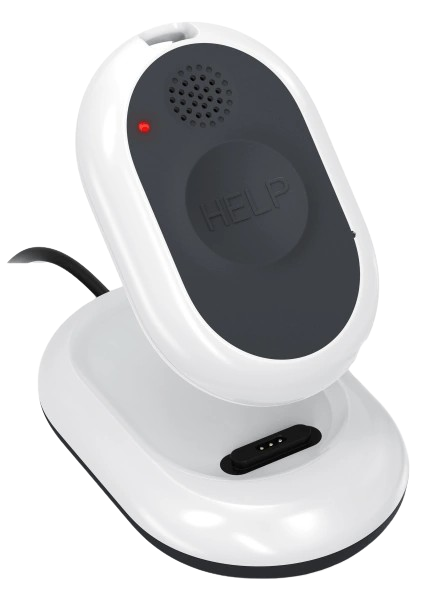Newfoundland And Labrador Lone Worker
Our Safety Policy Guide For Lone Workers In Newfoundland And Labrador
In Canada, federal and provincial/territorial jurisdictions govern laws and policies. While Newfoundland and Labrador adhere to Canada’s federal Occupational Health and Safety Code for employment policies related to lone workers, the province also emphasizes its own unique practices.
Employers in Newfoundland and Labrador can benefit from guidance tailored to the challenges faced by lone workers in this region. This page highlights the recommendations and best practices specific to the province.
On This Page
Our Guide To Lone Worker Safety Policy And Legislation In Newfound And Labrador
Being a lone worker can present unique risks and challenges in Newfoundland and Labrador, making it essential for employers to follow the policies and regulations outlined by both Newfoundland and Labrador law and Canadian federal law.
This page will summarize key considerations for employing lone workers in Newfoundland and Labrador, including how to meet the hazard assessment and control standards defined in the Occupational Health & Safety Code (OHS).
How Newfound And Labrador Defines A Lone Worker
In Newfoundland and Labrador, a "lone worker" is generally understood as an individual who works by themselves without routine interaction with other workers, customers, or the public, or is in an isolated location where they cannot be easily seen or heard by others.
Lone workers include those handling cash, traveling to meet clients, working in remote or isolated areas, performing hazardous tasks, or working in environments with a heightened risk of violence due to isolation.
Employing A Lone Worker In Newfound And Labrador
Employers in Newfoundland and Labrador are advised to assess workplace hazards, implement safe work practices, and minimize lone work whenever possible. Best practices include maintaining regular communication with lone workers through check-ins or communication devices, providing training on workplace hazards, ensuring the availability of emergency supplies, and using security systems like video surveillance or GPS locators.
Employers should also develop tailored procedures such as safe visit plans, travel plans, and safety awareness checklists for various lone worker scenarios, ensuring hazards specific to their roles are mitigated. Workers are encouraged to follow employer-initiated safety measures and report unsafe conditions immediately.
Learn How You Can Protect Your Employees With Loneworker.com

With Loneworker.com you can be equipped with the knowledge and the means to protect your employees and protect your business. Contact us today to learn more about how Loneworker.com can protect you and your employees.
How The Safe Lone Worker App Can Protect Newfound And Labrador Lone Workers And Employers
An important part of keeping your lone workers safe is providing quick and easy communication and monitoring in the event of an emergency.
With the Safe Lone Worker App, you can easily monitor your employees' while they are carrying out their responsibilities, even if they are travelling alone. The app works in tandem with a man down alert button that can be pressed in the event of an emergency. If the button is pushed, the lone worker will be immediately put into contact with a monitoring center that can send help immediately and contact the employer.
Newfoundland And Labrador Lone Worker Policies
The content below has been included as a direct reference for lone worker policies as provided by Newfoundland And Labrador. This content has been included to serve as more detailed information and an easy reference point. This information is provided for your convenience, but should not be taken as legal advice. We encourage you to conduct your own research into the laws and regulations of your jurisdiction before making any decisions.
Occupational Health and Safety Act
Newfoundland and Labrador’s Occupational Health and Safety Act sets standards to protect and promote the health and safety of workers throughout the province. The Act outlines the rights and responsibilities of employers, workers and others who are at the workplace. Under the Act, employers must do everything reasonable to protect the health and safety of workers. This means that employers must set up safe work practices at their workplace and make sure these practices are followed. It is up to the employer to make sure workers have the skills and training needed to perform their work safely. Workers are required by the Act to work safely and cooperate with their employer by following health and safety rules. Workers must be told about any dangers at the job site.
Employers can reduce the risk of workers working alone if, wherever possible, they organize work schedules and procedures to eliminate or reduce the occurrence of working alone.
Working Alone Situations That May Put Workers At Risk
Workers who work alone can be grouped into five broad categories:
- 1. Workers who handle cash. This includes convenience store clerks, retail food outlet workers and taxi drivers.
- 2. Workers who travel away from base office to meet clients. This includes sales workers, home care workers, social services workers and law enforcement officers.
- 3. Workers who do hazardous work but have no routine interaction with customers or the public. This includes workers in the logging and oil and gas industries.
- 4. Workers who travel alone but have no routine interaction with customers or the public. This includes truck drivers and business people in transit.
- 5. Workers who are at risk of violent attack because their workplace is isolated from public view. This includes security guards and custodians.
Each of these situations has different hazards and ways to control them.
What Employers Can Do To Help A Lone Worker Stay Safe
There are many steps that can be taken to help ensure the safety of the lone worker.
- Assess the hazards of the workplace.
- Talk to workers about their work. Get their input about the work they do and possible solutions.
- Investigate incidents at the workplace, and those from similar workplaces.
- Avoid having a lone worker whenever possible, especially for jobs with a recognized risk.
- Take corrective action to prevent or minimize the potential risks of working alone.
- Provide appropriate training and education.
- Report all situations, incidents or “near misses” where working alone increased the severity of the situation. Analyze this information and make changes to company policy where necessary.
- Establish a check-in procedure. Make sure regular contact is kept with all workers.
- Establish ways to account for people (visually or verbally) while they are working.
- For most lone workers, the telephone will be the main source of contact. If work is at a desk or station, have a telephone close by. If work is away from a main office or work station, the use of a cellular phone is very helpful. If a cellular phone is unreliable in the area, be sure to have alternative methods of communication available (such as use of public telephones, site visits or satellite technology.)
- Schedule high risk tasks during normal business hours, or when another worker is capable of helping if an emergency situation arises.
- Position workers, where possible, in locations of highest visibility.
- Keep windows clear to allow the worker to be clearly visible to the public.
- Allow the use of a “buddy system” in high risk situations – ensure that workers are aware that this option is available to them.
- Where appropriate, use a security system such as video surveillance cameras, mirrors, observation windows, etc., however, ensure that informed consent is obtained from employees prior to use.
- Where appropriate, provide employees with a Personal Locator Beacon with GPS Interface.
Learn How The Lone Worker Monitoring Device Works.

By using a Safe Lone Worker Man Down alert you can monitoring your employees and keep them safe even while they are travelling or working on their own.
Our devices are equipped with cellular and GPS technology to provide service all across Canada and the United States of America.
Contact us today to get your Safe Lone Worker Man Down Alerts for you and your business.
What Workers Can Do To Stay Safe
Workers can stay safe by adhering to the appropriate measures initiated by the employer and reporting any unsafe conditions to their immediate supervisor.
Workplace Hazard Assessment
Factors to consider when assessing workplace situations.
The following are some points to consider. Each circumstance will be different.
- 1. Length of time the worker will be working alone:
- 1. What is a reasonable length of time for the worker to be alone?
- 2. Is it reasonable for the worker to be alone at all?
- 3. How long will the worker be alone to finish the job?
- 4. Is it legal for the worker to be alone while doing certain activities? (For example: Newfoundland & Labrador and possibly other jurisdictions restrict working alone in confined space or during lock-out/tag-out operations).
- 5. What time of the day will the worker be alone?
- 2. Communication:
- 1. What forms of communication are available?
- 2. Is it necessary to “see” the work, or is voice communication adequate?
- 3. Will emergency communication systems work properly in all situations?
- 4. If the communication systems are located in a vehicle, do you need alternate arrangements to cover the worker when away from the vehicle?
- 3. Location of the work:
- 1. Is the work in a remote or isolated location? (Remember, a remote location does not have to be far away. Storage rooms that are rarely used can be considered remote or isolated.)
- 2. Is transportation necessary to get there? What kind of transportation is needed?
- 3. Is the vehicle equipped with emergency supplies such as – food, drinking water and a first aid kit?
- 4. Will the worker need to carry some or all of the emergency supplies with him/her when leaving the vehicle?
- 5. What are the consequences if the vehicle breaks down?
- 6. Will the worker have to leave the vehicle for long periods of time?
- 7. Does the worker need training to be able to use the first aid equipment?
- 4. Type or nature of work:
- 1. Is there adequate training and education provided for the worker to be able to work alone safely?
- 2. If personal protective equipment is required, is it available, is it in good working order, and has the worker been trained in its use, care and storage?
- 3. What machinery, tools or equipment will be used?
- 4. Is there a high risk activity involved?
- 5. Is fatigue likely to be a factor?
- 6. Are there extremes of temperature?
- 7. Is there risk of an animal attack, or poisoning/allergic reaction from insect/animal bites?
- 8. If the worker is working inside a locked building, how will emergency services be able to get in? (For example: a night cleaner in a secure office building.)
- 9. Does the work involve working with money or other valuables?
- 10. Does the work involve seizing property or goods (such as repossession, recovering stolen property)?
- 5. Characteristics of the individual who is working alone:
- 1. Are there pre-existing medical conditions that may increase the risk?
- 2. Does the worker have adequate levels of experience and training? (For example: first aid, communication systems repair, vehicle breakdowns, relevant administrative procedures and/or outdoor survival.)
Workers Who Handle Cash
The primary risk to workers who handle money and valuables is the potential of violence. The main motivating factor is robbery. Research has shown that the following types of industries are at the greatest risk of robbery and workplace assault:
- liquor stores
- gasoline service stations
- jewelry stores
- convenience stores
- eating and drinking places
- taxis
- Cash Handling Policy – Businesses that take steps to reduce the amount of cash on hand (through the use of devices such as drop safes), and who publicize the fact, lower the incentive for robbers to select them as a target. A good cash control policy is considered the most effective deterrent.
- Good Visibility – If a business can place its cash handling in an area of high visibility, the chances of robbery can be greatly decreased.
- Robbery Awareness Training – Workers and employers can act to reduce their risk of robbery if they are trained.
- Security Systems – Robbers do not want to be identified; therefore, security systems are a good deterrent.
- Protective Shielding – Although not commonly used in business, protective shielding can be a control measure in reducing the risk of violence.
Workers Who Meet Clients Away From Their Base Office
Workers who meet clients away from the office may face an unfamiliar environment and unpredictable client behavior. Risks in such situations include assault, robbery and verbal abuse. Prevention strategies include using a safety checklist and having a safe visit plan to guide workers to carry out their job safely. Workers in this category include home care workers and nurses, real estate agents, social services workers and law enforcement workers.
- 1. Safe Work Procedure – The employer should develop a standard safety awareness checklist so workers can evaluate their own risk. The evaluation should take into consideration client behavior, location, previous experiences and the presence of other dangerous items – e.g. weapons.
- 2. Safe Visit Plan – A safe visit plan should be made if workers are entering a potentially unsafe situation. The plan should outline control measures chosen to help the employer track the safety of workers working at the client’s premises. Control measures include using an active communication system, switching the meeting place to a safer and more friendly location, or using “two workers” to eliminate working alone.
Workers Who Perform Hazardous Work Alone
Workers who perform hazardous work alone, without routine interaction with other workers and the public, may be unable to get immediate help. The primary prevention strategy is to control the hazards associated with the work. Industries that have workers in this category are forestry (e.g., loggers) and oil and gas.
- 1. Safe Work Procedures – Having written safe work procedures for hazardous work is essential.
- 2. Equipment Safety – The employer must ensure that workers use equipment as intended and according to the manufacturer’s specification. All equipment used in a workplace must be maintained in good working condition, whether or not it is being used in a “working alone” situation.
- 3. Equipment and Supplies – In addition to proper equipment, appropriate first aid and emergency supplies must be provided to workers who are working alone at a work site.
- 4. Travel Plan – If workers are working alone in a remote location, the employer should establish a sign-out procedure to track their whereabouts. An “overdue employee” procedure should also be in place for locating workers who fail to report on time.
Workers Who Travel Alone
Some of the risk to workers who travel alone involves injuries from motor vehicle accidents. The risk is greater when workers in remote areas are unable to summon help. Workers performing fieldwork alone, workers in the transportation industry and business people in transit are exposed to the risk.
- 1. Safe Work Procedures – Workers must have full concentration on the road when traveling alone. An employer should allow sufficient rest time for workers who are traveling on long trips.
- 2. Equipment and Supplies – Well-maintained vehicles prevent exposure of workers to unnecessary risk. Appropriate first aid and emergency supplies should be provided.
- 3. Travel Plan – An employer should consider a procedure appropriate to the hazards to track the whereabouts of their workers. The travel plan submitted by the employees can be used to assess the rest time available to the employee traveling alone.
Workers At Risk of Violence Because They Are Isolated
For workers who work in isolation away from routine contact with other workers, there is a risk of violent attacks by intruders. Workers in this category include custodians and security guards. Site security is therefore the most important control measure.
- 1. Safe Work Procedure – The employer should have safe work procedures directing workers to check the security of the workplace at the beginning and at the end of the shift. The procedures should also include how to behave when confronted with an intruder.
- 2. Site Security – A secure facility with a proper security system is the primary defense against break-ins.
References
Working Alone Safely Guidelines for Employers and Employees - Digital Government and Service NL.” Digital Government and Service NL, 6 July 2023.
Government of Canada, Canadian Centre for Occupational Health and Safety. Working Alone - General. 10 May 2024.
Loneworker.com is an aggregate resource and is not directly affiliated with government policies, legislation, or guidelines. Our site is intended to gather and display information for your use, but you are encouraged to conduct your own research.
Newfound And Labrador Lone Worker Resources

WorkplaceNL
St. John's
- 709-778-1000
- Toll Free 1-800-563-9000
Grand Falls-Windsor
- 709-489-1600
- Toll Free 1-800-563-3448
Corner
- 709-637-2700
- Toll Free 1-800-563-2772

Lone Worker And Employment Facts In Newfound And Labrador
243,200 People Are Employed In Newfoundland And Labrador
Educational Services And Wholesale And Retail Trade Make Up The Majority Of Newfoundland And Labrador’s Employment Industry
Affordable Monitoring For Lone Workers In Newfoundland And Labrador

-
 Monitoring Your Employees' Safety
Monitoring Your Employees' Safety
-
 GPS Tracking And Monitoring
GPS Tracking And Monitoring
-
 Man Down Panic Alerts
Man Down Panic Alerts
-
 24/7 Protection Anywhere
24/7 Protection Anywhere
Lone Worker Legislation
Lone Worker Safety Policies And Legislation By Province
-
 Alberta Provincial Safety Policies And Legislation
Alberta Provincial Safety Policies And Legislation
-
 British Columbia Provincial Safety Policies And Legislation
British Columbia Provincial Safety Policies And Legislation
-
 Manitoba Provincial Safety Policies And Legislation
Manitoba Provincial Safety Policies And Legislation
-
 New Brunswick Provincial Safety Policies And Legislation
New Brunswick Provincial Safety Policies And Legislation
-
 Newfoundland and Labrador Provincial Safety Policies And Legislation
Newfoundland and Labrador Provincial Safety Policies And Legislation
-
 Nova Scotia Provincial Safety Policies And Legislation
Nova Scotia Provincial Safety Policies And Legislation
-
 Ontario Provincial Safety Policies And Legislation
Ontario Provincial Safety Policies And Legislation
-
 Prince Edward Island Provincial Safety Policies And Legislation
Prince Edward Island Provincial Safety Policies And Legislation
-
 Quebec Provincial Safety Policies And Legislation
Quebec Provincial Safety Policies And Legislation
-
 Saskatchewan Provincial Safety Policies And Legislation
Saskatchewan Provincial Safety Policies And Legislation
-
 Northwest Territories Provincial Safety Policies And Legislation
Northwest Territories Provincial Safety Policies And Legislation
-
 Nunavut Provincial Safety Policies And Legislation
Nunavut Provincial Safety Policies And Legislation
-
 Yukon Provincial Safety Policies And Legislation
Yukon Provincial Safety Policies And Legislation







